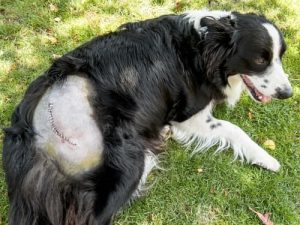Surgical wound repair in dogs is a common procedure and includes using stitches, staples, and other healing methods. Wounds in dogs can range from small, shallow wounds to larger, deeper wounds. Different techniques are needed for repair, depending on the type of wound.
Wounds in dogs are common and can develop due to a variety of causes, such as dog bites, stick injuries, and burns. Surgical wound repair, also known as surgical wound management, is often called a stitch-up, as most commonly sutures are used. Sedation or general anaesthesia is usually required for surgical wound repair.
What it’s for
Why is surgical wound repair needed in dogs?
Surgical wound repair plays a crucial role in the healing process of all different kinds of wounds, such as tears, lacerations, bites and various others. Stitches, staples or surgical glue may be used to close wounds. Some wounds can be left open to heal, but many wounds heal more quickly and effectively when closed via surgical techniques.
Other reasons why surgical wound repair is needed include:
- Prevention of infection and control of bleeding
- Reducing pain or discomfort
- To minimise scarring
How it’s done
How is surgical wound repair done in dogs?
For surgical wound repair, dogs are usually admitted to the vet practice for the day:
- You bring your dog into the vet practice, usually first thing in the morning. They get a physical exam by a vet, then are given a comfortable kennel for the day.
- They are given sedation or anaesthetic medication, depending on the procedure.
- The wound is thoroughly cleaned and any foreign material or dead tissue is removed.
- The wound is then stitched/sutured together; this might be in multiple layers.
- If the wound is very large or there is not enough skin to pull together, different techniques may be used, such as skin grafts, flaps and tension-relieving sutures.
- A drain may be placed if help is needed to remove excess fluid.
- Once the procedure has finished, your dog is slowly woken up and monitored until they are safe to go home.
A lot of wounds are seen out-of-hours as emergencies, but the steps are very similar.

- Dog with stitches
The exception to this is if your dog only needs a couple of staples; this can sometimes be done in a consultation without any sedation or GA. However, this is not common.
How to prepare your dog for surgical wound repair
Keep the wound as clean and dry as possible, and prevent your dog from licking at it.
If your dog needs sedation or a general anaesthetic (GA), they will likely need to be starved for 12 hours beforehand.
Why your dog needs sedation/GA for surgical wound repair
Sedation or GA, is important for several reasons:
- To relax your dog if they get stressed or anxious at the vet clinic.
- To keep your dog restrained. It allows your vet to thoroughly clean the wound and perform surgery with better precision, giving a better chance of a good outcome.
- Wound cleaning, stitches, or any other type of surgery are painful. Medications used for sedation or anaesthesia provide additional pain relief properties.
Costs
How much does it cost for a stitch-up in dogs?
The cost of surgical wound repair can vary depending on the following factors:
- Geographical location
- If your dog is seen as an emergency, out of hours, or during normal business hours
- The size and weight of your dog
- How severe the wound is and the type of surgery needed. Staples are often quicker, so they tend to be less expensive than other techniques such as skin grafts, drains and extensive suture repair.
- Sedation and GA costs include monitoring equipment, extra staff, and specific medication. This often starts at around £100-200 or more, depending on how long the procedure lasts.
- Other costs to consider include bandaging, antibiotics and pain relief to go home with.
Risks
Is surgical wound repair in dogs safe?
Surgical wound repair is generally a safe procedure. Sedation and general anaesthesia are also considered low-risk in most dogs; complications can happen, but they are not common.
The main risks of surgical wound repair are:
- Wound infection
- Wound breakdown
- Bleeding
Recovery tips
How to help your dog after surgical wound repair
In most cases, your dog will come home on the same day they had surgical wound repair. It’s important to closely monitor them for anything abnormal. Most dogs are back to their normal selves within 24-48 hours, but they will normally need to rest for longer.
- Your dog may be more vocal or restless compared to normal.
- Make sure they have a comfortable and quiet area to rest and sleep.
- Reduce exercise for as long as instructed. This is extremely important for healing. Sometimes, cage rest may be recommended.
- Give any medication as advised by your vet.
- Monitor the surgical wound for discharge or swelling and prevent self-trauma (licking!) at all times.
- If bandages are used, keep them clean and dry. Take your dog back to the vet to have bandages replaced if they become wet or displaced.
When to worry
When should you be worried about surgical wound repair in dogs?
Seek help from a vet if:
- Your dog has breathing problems or is collapsed after surgery
- Your dog’s wound is smelly, swollen or has pus
- Your dog is in pain after surgery
Call us and speak to one of our Joii vets if:
- Your dog has a minor wound
- You need any advice on keeping your dog mentally stimulated during rest
- You have any questions about sedation or general anaesthesia in dogs








